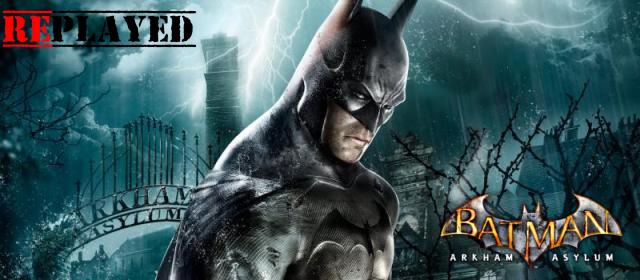By and large, 2009 was a good year for games. New franchises were born in Dragon Age: Origins, Borderlands and Bayonetta, while several sequels emerged to surprise us by improving on already impressive originals (Uncharted 2: Among Thieves and Left 4 Dead 2 being prime examples). But it was also the year when the boggy, uninhabitable no man’s land between video games and comic books would finally be tamed, re-turfed and built over with Rocksteady’s tour-de-force of game design, Batman: Arkham Asylum.
Ignoring Christopher Nolan’s hugely popular big-screen franchise reboot, Arkham Asylum instead took its inspiration from Grant Morrison and Dave McKean’s 2004 graphic novel ‘A Serious House on Serious Earth’. An open-world adventure game, Arkham Asylum immediately raised eyebrows by not being shit, something that superhero games had largely failed to achieve in the past. Now, four years on, and with the recent announcement of prequel Batman: Arkham Origins, I thought it would be a good time to get Asylum back in the tray and re-examine that winning formula.
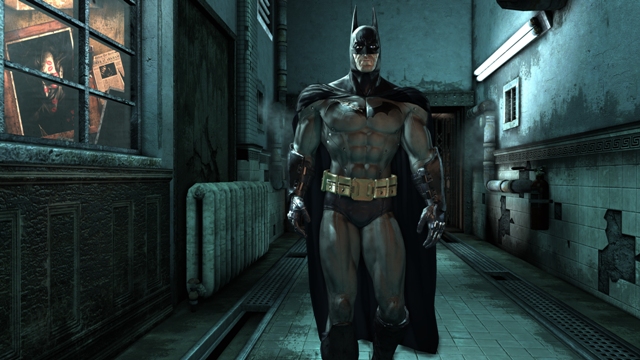
BAT’S ENTERTAINMENT: Four years doesn’t seem like a very long time in the real world, but in video games it’s long enough to make considerable advancements, and something that was cutting edge only 48 months ago can seem old and creaky when examined under a modern light. Thankfully, Arkham Asylum remains a long way from creaky.
The open-world sub-genre has been prevalent in the last few years, with titles like Red Dead Redemption, Sleeping Dogs and Prototype 2 offering their own unique takes on an established formula, but, despite one or two brave developers borrowing elements from Arkham Asylum (notably the incredible combat system), it remains one-of-a-kind thanks to its balanced combination of brutal action, hi-tech gadgetry, stealth and sleuthing.
Successful innovation tends to inspire two reactions among peers: either they’ll copy what you’ve done in an attempt to emulate your success, or they’ll give your ideas a wide-berth as they lack the confidence to competently execute them. So, really, the fact that very few developers have attempted to recapture Arkham Asylum’s wonderfully fluid combat and heavy atmosphere is testament to Rocksteady’s accomplishment.

ARKHAM BEGINS: Based in Kentish Town in London, Rocksteady were a relatively unknown quantity before the release of Arkham Asylum, with only last-gen FPS Urban Chaos: Riot Response on their CV. To say that Arkham Asylum “put them on the map” is trite but true, and quite overnight they became huge, even winning the Best Developer gong from the 2009 Spike TV Video Game Awards.
It was well-deserved, too. Pre-release, Asylum looked good, but no one expected it to be as compelling as it turned out to be. As stated, Rocksteady’s game uses the concept of ‘A Serious House on A Serious Earth’ as its main jumping off point. While the actual plot is very different, the initial premise of Batman entering a madhouse overrun by a gang of psychotic inmates led by the Clown Prince of Crime himself is the same. It’s the perfect set-up for an open-world action game with a sizeable dose of stealth and bone-crunchery.
There’s a wonderful moment when the game begins, as Batman first enters the Asylum alongside Mark Hamill’s Joker, a sniggering wind-up merchant intent on getting Brucey’s back up. It’s all a distraction, of course, keeping the Bat talking and walking while his prisoners prepare to take the facility under the leadership of the Joker’s psychotic squeeze Harley Quinn. The scene expertly captures the relationship between hero and villain, a hate-hate dynamic that forms the backbone of the plot – a plot that delves into a ridiculously vast treasure trove of Batman lore.
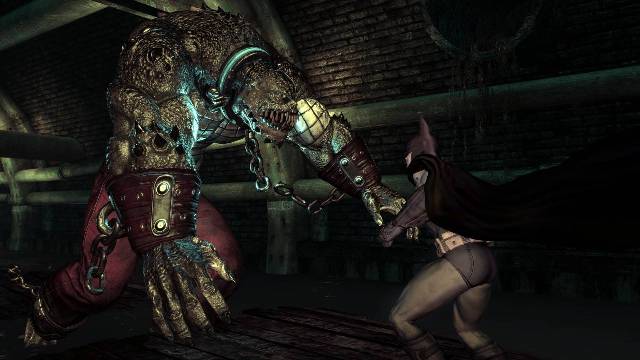
ROGUE’S GALLERY: Never before have so many super-villains been wedged into one space, and the dimly-lit corridors of Arkham Asylum are bursting at the seams with scheming evil-doers. Not only does it cater for a huge array of boss-fights, which we’ll get to, but it allows for a deep and engaging story about the Bat himself. The narrative floats such a colourful cast of characters by you that it’s hard not to get caught up in all the backstories, character bios, and intricate little asides and forget you’re supposed to be taking them all out.
The Riddler, in particular, is a treat. Playing a less-prominent role in this game than in the sequel, he nevertheless hangs around the place to make Batman’s life that little more difficult – and provide many great opportunities to use Detective Vision, Batman’s version of Spidey-sense that highlights clues to follow and secrets to uncover (as well as presenting your patrolling enemies in bright blue X-Ray vision). A large selection of his riddles allude to other villains, even those who don’t turn up in the Asylum – particularly those who are most conspicuous by their absence. Catwoman, The Penguin and Two Face fail to bag any screen-time, while minor players like Victor Zsazs pop up – which of course all makes perfect sense when the plot continues apace in Arkham City.
However, the best thing the line-up of villains brings to the party is the great selection of boss fights. Highlights include a heart-racing run through the sewers with Killer Croc in pursuit, and a surreal, head-trippy battle between a giant Scarecrow and a drugged Batman. Throw in Poison Ivy and the hulking meat-head Bane and it’s a party. The mix of stealth, boss fights and impressive storytelling ensures that the narrative hurtles along at a fair-old pace, and it’s Rocksteady’s attention to detail and obvious love for the source material that makes Batman: Arkham Asylum as compelling and likeable as it is.
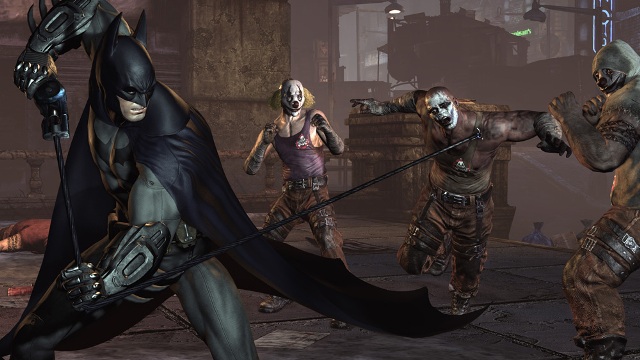
WHY SO SERIOUS? The actual crux of the plot (written by veteran Batman scribe, Paul Dini) revolves around a serum that the Joker is developing from Bane’s blood that will create an army of super-beefed-up criminals with him at the helm. Besides the interplay with the villains, however, the story is moved from boss-fight to boss-fight by way of a series of intense single-room scenarios, with the central courtyard of the Arkham compound acting as a kind of hub. There are things to do in each area of the Asylum, if you can get past the Joker’s goons first.
The criminals of Arkham aren’t the smartest bunch, but they’re a great way for Rocksteady to bring Batman’s unique skill-set to the fore. Some scenarios will see you fighting hand-to-hand with groups of five or more, and the robust combat system is built around Master Wayne thriving when in the thick of it. For that reason you’re equipped with an attack and counter button. Simple combos are damaging enough, but hit the counter button at the exact moment the enemy flashes with a tell-tale symbol and Bats will deliver a devastating counter-attack. A competent, well-timed mixture of the two will see the Caped Crusader bouncing around the screen, chaining blows together with lethal effect – to the extreme that it’s possible to take down a gang of nine or ten thugs within a single, unbroken combo.
The combat is sublime and, despite the overall quality of every facet of Arkham Asylum, manages to be the true stand-out factor. It’s effortlessly satisfying, and even when the game starts arming cons with guns, knives and tasers it gives you the tools and the moves to take them down. Levels are raised by earning XP that can be spent on melee moves and equipment upgrades for Batman’s arsenal of gadgets – many of which are there to facilitate the rather incredible and empowering stealth.
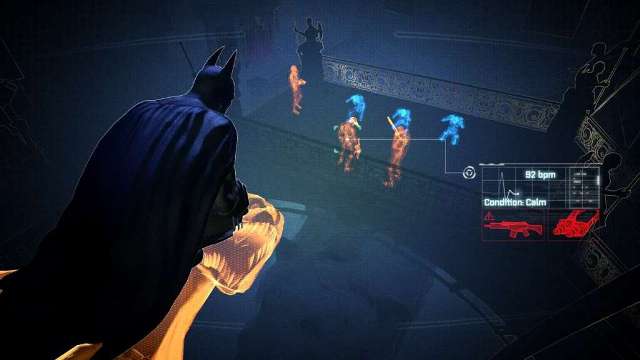
I AM THE NIGHT: It wouldn’t be Batman without being able to use the darkness to your advantage, and Arkham Asylum has a brilliant stealth element that makes you feel badass in a way that even franchises like Metal Gear Solid and Splinter Cell never quite managed. It’s all thanks to a combination of Batman’s Detective Vision and his selection of gizmos: remote-controlled batarangs, high-tech explosive gel, and, of course, the grapple gun and cloak that facilitate swinging and gliding around the rafters, alighting on gargoyles from which to survey your enemy’s movements and attack silently – no other game has ever let you be Batman to such an extent as this.
It’s not always perfect, unfortunately, and occasionally a gang of thugs will get spooked and run around like headless chickens for a while before eventually returning to their patrol as if they didn’t just spot their buddy hanging upside down from a gargoyle’s maw. It’s also too easy to evade them, too, as simply swinging up into the shadows will render Bats practically invisible, and it doesn’t take much to completely overpower a room full of goons.
Still, the stealth and melee elements are so cool that Rocksteady saw fit to include a host of Challenge Rooms to put all of Batman’s skills to the test – well, your skills really, as some of them are incredibly difficult to master. They also post your completion times online so you can show off your awesomeness. Or lack thereof, as the case may be.
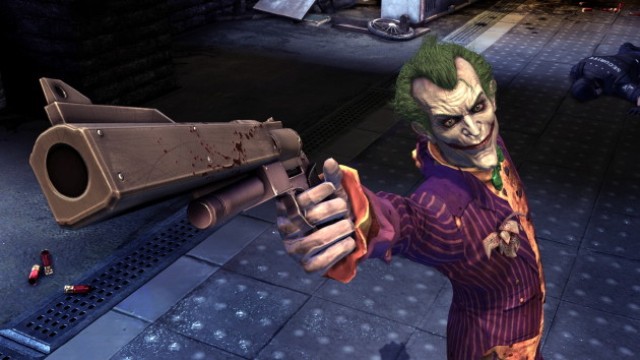
JOKER IN THE PACK: In the end, it’s a combination of things that makes Arkham Asylum so eminently playable. The atmosphere – apparently influenced by Irrational Games’ Bioshock – is dark and brooding, but not as oppressive as you’d expect because Bats is just too badass for you to ever feel under pressure. This minor issue was resolved in the sequel by Rocksteady ramping up the difficulty and adding new layers of challenge with better-equipped goons and more obstacles.
The brilliant interplay between Batman and the colourful carnival of villains and super-villains doesn’t just keep the narrative rolling, but weaves an intricate universe from the rich source material that may take elements from the graphic novels and the animated series (Kevin Conroy, Mark Hamill and Arleen Sorkin all lend their voices to Batman, the Joker and Harley Quinn in the show), but stands on its own, not only as a great Batman game, but as an excellent open-world adventure in its own right.


